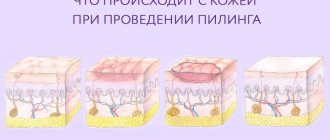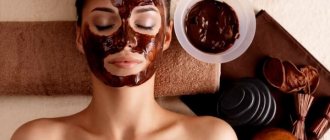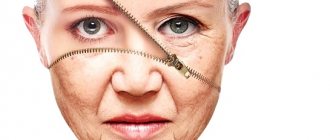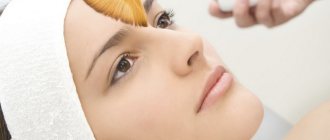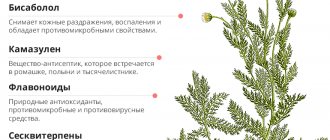Having decided to write an article on the topic “Chemical Peels,” I did not doubt for a second that I would not be doing this alone, because in practice, cosmetologists perform superficial-medium, medium and deep peels, and superficial ones are performed by cosmetology nurses. Therefore, my “right hand”, Alexandra, also took an active part in writing this article.
Everyone knows that since 2009, the profession of “cosmetologist” has officially appeared in Russia, a well-known division into “household” has taken place, and hairdressing salons, which offered “Botox injections,” have become a thing of the past. Nowadays, medical centers providing cosmetology services usually employ cosmetologists and cosmetology nurses. And this is no coincidence. The initial consultation, of course, is carried out by doctors, but then there is a “separation of powers”, all injection procedures are performed by cosmetologists, and procedures without damaging the skin are performed by cosmetology nurses. These include all types of cleansing (including ultrasonic and mechanical), massages, cosmetic treatments, eyebrow and eyelash architecture, various options for hair removal and depilation, as well as superficial chemical peels.
Benefits of peeling
Facial peeling is one of the care procedures that is useful at any age. It is used for:
- cleansing,
- rejuvenation,
- smoothing out wrinkles, scars and unevenness,
- evens out skin color and tone,
- helps with pigmentation,
- restores elasticity,
- tones,
- tightens pores,
- prevents the appearance of pimples,
- helps slow down age-related changes.
Homemade peelings exfoliate the upper dead particles, accelerating the restoration of the skin. This allows you to cleanse, rejuvenate and add tone to the skin. The benefits of facial peeling allow you to use it at any age. This is a universal remedy for ongoing care and solving real problems:
- acne
- blackheads
- clogged pores
- presence of pigmentation
- wrinkles of varying depths
- scars, bumps and pimple marks
- promotes the production of collagen and elastin
- to maintain youth and beauty at any age.
Facial peeling will help solve and prevent all these skin problems. But what is peeling like? How to choose for yourself?
Rehabilitation
After chemical peels, you need to take good care of your skin to give it a chance to recover. First of all, hydration is necessary. It is recommended to use products with hyaluronic acid, panthenol, aloe and vitamins. In addition, you should avoid any aggressive procedures, the use of alcohol-containing cosmetics, retinoids, and mechanical scrubs. When crusts appear, you cannot remove them yourself - you should be patient and wait until they fall off spontaneously.
It is extremely important to protect your face from ultraviolet radiation. The renewed epidermis is especially sensitive to such effects, so the risk of age spots increases. So the use of protective lotions with a high SPF factor is mandatory not only in the summer (when peeling is generally not recommended), but also in the winter.
To maintain the effect, your doctor may recommend using special cosmetics containing acids. They can be included in creams for everyday use in low concentrations sufficient to preserve the results for a long time.
After superficial treatment, the skin is restored quickly, however, during the entire course and two weeks after its completion, careful care and avoidance of any aggressive influence are necessary.
Types of facial peels
Facial peeling can be of several types.
Mechanical – differs little from a facial scrub. Use at home without fear. This is the safest type for home use. You can buy it ready-made or make it yourself. Can also be used as a mask. Which will save time. Recipes below.
Chemical peels for the face have different effects. But all penetrate deeper into the skin structure than mechanical ones. Some help exfoliate, others stimulate increased cell regeneration. When using chemical peels, it is recommended to consult a specialist to determine the best option.
Applying acids to the face on your own without consultation can cause burns, redness and lead to the exact opposite effect. The exception is salicylic, fruit and lactic acids, which are the safest for independent use. Homemade recipes using them are below.
Diamond peeling is a salon procedure using a special device. Allows you to literally remove the stratum corneum of the skin. Recommended by cosmetologists for severe damage and the need for quick and deep rejuvenation.
Peeling roll - unlike mechanical peeling, contains sticky components. Due to this, impurities are pulled out of the pores. Differs in different types of aggressiveness. May contain additional components for lightening, nutrition, relief of inflammation, etc.
At home, facial peeling is most often used mechanically. If you make it yourself, add the ingredients necessary to solve your problem. Detailed recipe descriptions below.
What it is?
Healthy skin is constantly renewed, and the upper - horny - layer of the epidermis consists of dead cells. They gradually peel off, giving way to new ones. If this process slows down, the layer of dead cells becomes too thick. As a result, the breathing of the skin is disrupted, its surface becomes uneven, the complexion deteriorates, and other defects appear.
They contain acids that dissolve dead cells and stimulate the process of exfoliation of the upper layer of the epidermis. More concentrated formulations affect both the middle and deep layers of the skin.
At its core, the procedure is a controlled damage (chemical burn) to the skin. The body reacts to such exposure with intensive restoration and cell renewal: damaged layers are replaced with new ones. As a result, the face looks much younger and fresher.
The history of chemical peelings began in ancient times, when beauties used wine, fruit juices and fermented milk products to prolong their youth. The development of chemistry in the late 19th and early 20th centuries gave women effective but unsafe peelings using concentrated acids and toxic substances. They were popular with the most desperate ladies who wanted to preserve their beauty for many years at any cost. Only later, at the end of the 20th century, when scientists studied the properties of alpha hydroxy acids (AHA), modern superficial and medium peels appeared - delicate but effective. Such procedures quickly gained popularity, and now cosmetology clinics offer a wide variety of options to suit every taste.
Contraindications and precautions
When using peeling at home or with a cosmetologist, you should remember a number of rules. Contraindications to the procedure:
- presence of wounds or cracks
- close location of the vascular network to the surface of the skin
- windiness
- severe inflammatory process
- temperature increase
- colds or viral diseases
- diabetes
- taking antibiotics
- allergic reactions to formulations or individual ingredients
- pregnancy
- fungal infections
Sunbathing after the procedure is not recommended. Therefore, the most suitable time for home peeling is the evening, after removing makeup. This way the skin will have time to recover.
Remember that peeling is not applied to the eye area.
How to use facial peeling?
There are several steps for using peeling at home:
- Cleansing the skin of makeup
- Apply peeling
- Massage for 1-2 minutes if the composition contains solid particles
- Rinse off with running water
Sometimes it is recommended to steam the skin after removing makeup or wash with warm water to open the pores. This gives a deeper cleansing. Which is especially important for oily and problematic skin. If the peeling contains moisturizing, nourishing, and brightening ingredients, leave the composition on the skin for 1-3 minutes. Then massage and rinse off.
When using a commercial chemical peel:
- Cleanse your skin
- Apply for the specified amount of time
- Rinse with water or neutralizing solution
The instructions for the product usually include a detailed description of use. They may differ slightly depending on the type of acid in the composition.
It is important to avoid the eye area when applying any peel as it is delicate and sensitive.
After the procedure, be sure to apply a moisturizing composition to the skin. Facial peeling removes dead particles and initiates regeneration. Adjust the pressure when massaging. It should not be too strong so as not to injure the skin. Pay attention to the time. There is no need for prolonged exposure. It is enough to swipe the skin 2-3 times to get results.
Do not skimp on the composition; apply it in an even layer to the desired areas of the face and neck. Then start massaging movements. The composition should glide easily over the skin. To do this, it is recommended to wet your face with water.
Facial peeling at home gives a noticeable effect after the first use in this way.
By the way, peeling is applied both to the entire face and to
Recovery period
The duration of recovery after the procedure depends on the depth of acid exposure. So, after superficial peeling, recovery will take several days, after medium peeling – up to 14 days. Skin regeneration processes after deep peeling require more time - up to six months.
Regardless of the type of peeling and the duration of the recovery period, it is important to take care of your facial skin and follow your doctor’s recommendations. There are few restrictions during this period, but it is highly advisable to comply with them; first of all, it is to refrain from visiting the bathhouse, sauna and, of course, the solarium. Protecting the skin from ultraviolet rays, even in winter, is also the main rule during the recovery period. It is recommended to drink plenty of fluids and touch your face as little as possible.
In addition to generally accepted restrictions, there may be individual ones, which are prescribed by a cosmetologist. A professional specialist will also give recommendations on the use of skincare and decorative cosmetics during the recovery period after the procedure.
Facial peeling at home
At home, mechanical peeling is the safest. Gives a slightly less noticeable effect than a chemical one, but without the risk of burns. Ideal for comprehensive cleansing. It also gives a noticeable effect in anti-aging care. Especially with regular use. The composition usually has large or small particles; the product is made independently for your problem with the necessary ingredients. (See recipes below). Or you can buy peeling for home use. Other names are scrub or gaiter.
Chemical peeling of the face at home is possible if homemade recipes with products containing acids are used. Their concentration is minimal and not dangerous when using natural ingredients. For example, fruits, berries, etc.
Chemical peeling for the face using purchased products can also be used at home, BUT we recommend contacting a specialist to select the optimal product. Only a cosmetologist can determine which acid and in what dosage will help solve your problem with minimal risk.
About facial scrubs
Homemade facial peeling recipes
To make a facial peel at home, you will need natural abrasive ingredients. Usually present in every kitchen, in the nearest grocery store or pharmacy. Ground coffee, oatmeal, rice flour, salt, sugar, etc. are suitable.
The advantage of homemade formulations over store-bought ones is the ability to choose the optimal particle size and ingredients to solve your problem. For example,
- add a couple of drops of lemon juice if you need clarification,
- essential oil, if an antiseptic effect is needed,
- grind the base in a coffee grinder to a size you like,
- replace ground coffee with coffee grounds if you want a softer effect
Check out the recipes below, choose one for yourself and use it at home.
About coffee facial scrub
Cleansing facial peels
Cleansing is one of the essential stages of skin care. Cleansing with a peeling scrub is carried out 1-2 times a week for prevention or more often if there is
- serious pore contamination,
- frequent appearance of pimples
- for enlarged pores
- increased oily skin
About how to get rid of acne
About cleansing face masks
Cleansing peeling for oily skin
- salt and soda
We take the ingredients in equal proportions. Usually 1 tsp is enough. Mix. Add some clean water. Massage the entire face or only problem areas for 1-2 minutes. Wash off the homemade peeling with cool water. The composition cleanses, normalizes oiliness, and helps narrow pores. Suitable for problem skin and blackheads. For pimples, add 3-4 drops of tea tree essential oil.
About acne masks
For normal skin
- sugar, milk, pinch of cinnamon
Grind sugar (1 tsp) in a coffee grinder. But not to the point of powder, the particles should be a little larger, mix with cinnamon. Add the same amount of milk and massage your face for 1-2 minutes. Wash off with running water. Milk will not only provide cleansing, but also slightly moisturize. The tonic effect of cinnamon will improve skin tone.
For dry skin, cleansing peeling
- oatmeal, milk
Oatmeal is used whole or ground in a coffee grinder to the desired size. Mix in equal quantities and massage your face for 1-2 minutes to cleanse. To nourish, leave for 3-5 minutes. Then rinse with cool water
About acne clay
Composition selection
You can prepare a homemade peeling product yourself from natural products or buy a ready-made composition.
Let's look at what components will help cleanse the skin for different skin types:
- Dry. Low-abrasive components (flour, coffee grounds, pine nuts, crushed wheat flakes) are suitable for mechanical exfoliation of keratinized particles. The most suitable compositions for the chemical procedure are fruit pulp or juice, fermented milk products, honey, and herbal decoctions that are applied to the face.
- Fat. More aggressive agents are used (salt, soda, ammonia, boric acid, cane sugar).
- Normal. Peeling for this type of epidermis is preventive in nature. Vegetable pulp, coffee grounds, crushed tea leaves, ground oatmeal and nuts are suitable for the procedures. In order not to provoke thinning of the skin of the face, you should not get carried away with abrasive components.
- Fading. Aging dermis should not be subjected to aggressive cleansing methods. Good results are achieved by gentle peelings with fermented milk products (kefir, yogurt, sour cream), with oatmeal and milk, poppy seeds and sea salt with the addition of softening ingredients (vegetable oil, egg yolk, cream or honey).
When choosing a peeling composition, you need to take into account your skin type, age, the possibility of a recovery period, as well as the expected result. Better results can be achieved by using additional accessories (glove, brush or washcloth) during the procedure.
Rejuvenating peelings
By removing dead particles, peelings stimulate the skin to renew itself. With their help, unevenness and wrinkles are smoothed out faster, the color is evened out and the skin is delicately lightened. They also help provide essential nutrition and stimulate the production of collagen and elastin.
- clay, coffee, milk
Mix clay and ground coffee in equal quantities, add milk until it reaches a creamy consistency. Apply to face for 3-5 minutes. Then massage and rinse off.
About alginate face mask
Milk peeling for face
- milk, kefir, sour cream
Mix these dairy products in equal proportions and apply to a cleansed face for 10-15 minutes. Peeling nourishes, stimulates collagen production, moisturizes and smoothes wrinkles. Milk also promotes cleansing by dissolving fats.
Peeling mask for face
- protein, salt
For one chicken protein you will need a teaspoon of fine salt. Beat the whites with a whisk. Then we wash and apply salt with light massaging movements. Apply the protein on top with a brush. Leave for 3-5 minutes. We wash it off. Salt mineralizes and cleanses. Protein provides the skin with everything it needs for youth and beauty.
About moisturizing face masks
Fruit peeling for face
- apple, lemon, rice flour
Grate half an apple and squeeze out the juice through cheesecloth. Add half a teaspoon of lemon juice and tea flour. Mix well and apply to cleansed skin. Leave for 3 minutes and massage lightly. Acids cleanse and nourish well, rice flour stimulates rejuvenation.
- orange juice, coffee
Orange juice needs to be freshly squeezed. Take 1-2 tsp. ground coffee or coffee grounds. Add 1 tsp. juice Mix and apply with massaging movements. We get fruit peeling.
About face masks
Effect
After a course of procedures, the face becomes fresh and youthful. Peels are very popular precisely because the results are clearly visible. It can be appreciated not only by attentive observers - even casual acquaintances will notice a clear improvement in the condition of the skin.
Compliments are guaranteed after the first sessions, and by the end of the course:
- Improves and evens out complexion;
- Wrinkles are smoothed out and disappear;
- Elasticity and turgor increase;
- Pigmentation disappears;
- The skin becomes smooth and soft;
- Acne goes away;
- Scars are smoothed out, incl. from post-acne;
- Pores tighten;
- The functioning of the sebaceous glands is normalized.
Peeling courses combine well with other cosmetic procedures - both hardware and injection. A cosmetologist will tell you how best to combine different types of treatment to achieve optimal results.
